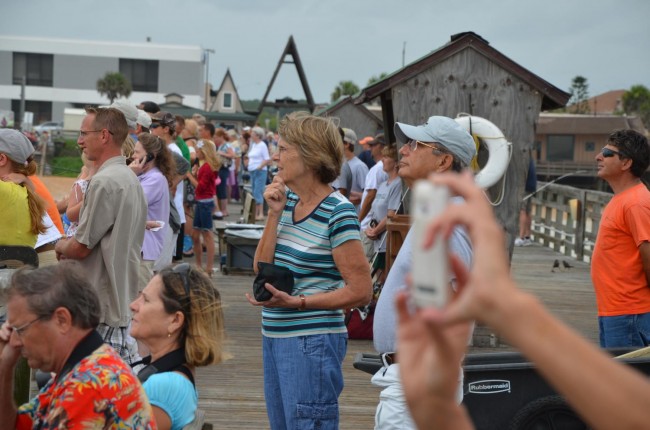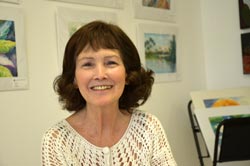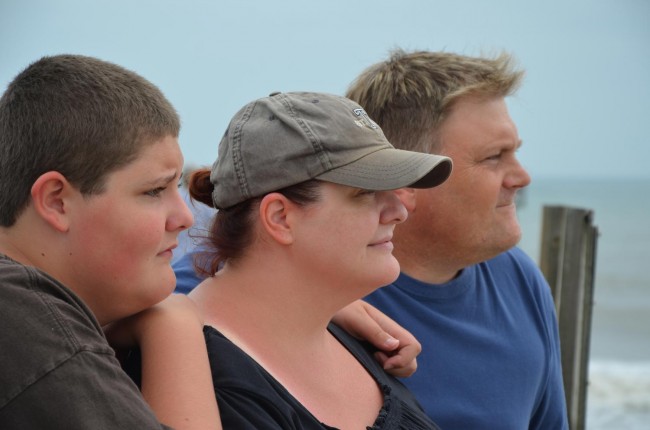
From Flagler Beach, the horizon this morning, within ticking heartbeats of the last space shuttle launch in history, looked as overcast-gray as the future of America’s manned space program. The area of the Kennedy Space Center was expecting close to 1 million people to see the shuttle drum-roll to the skies for the last time. It gets busy in Flagler Beach at launch time, but today the crowds were in every way subdued, as if reflecting emotions in numbers.
And when the moment came, at precisely 11:26:46 a.m, Atlantis’ last rise above the Atlantic looked, from all vantage points in Flagler County, like Atlantis’s mythological namesake, invisible. The clouds were too thick, the gray too dense to let that iconic upside-down candle, as it looks from this distance, show itself one last time. Not that it needed to. Like Atlantis, shuttle launches from this far off have always had to do more with the imagination than the rattle-and-roll details of the thing, which anyone could see on television if they so preferred. But they came to the beach, as they always have, because it’s about more than the details.
“We go to the beach every time and watch it, and everyone bursts into applause,” says Carol Fisher, owner of the Beachouse Beanery in Flagler Beach. “It’s just that whole kind of how to be an American kind of reaction that you don’t get to witness that often. The launch brings it out of everybody, at least the ones that go to watch it.”
Since the first test shuttle flew in 1976, the five shuttles have flown half a billion miles, beginning with Columbia’s majestic inaugural on April 12, 1981 and stretching over the 134 next flights by four more orbiters. Two never made it back: Challenger exploded after liftoff in 1986, Columbia disintegrated on reentry in 2003, leaving Discovery, Atlantis and Endeavour even then as NASA’s orphans. Now it’s as if the entire space program appears to have lost its moorings.
After carrying 355 people from 16 countries (including Saudi Arabia and Mexico), after taking up the first black astronaut (Guion Bluford in 1983), the first physician, the first veterinarian, and in John Glenn, the oldest (he was 77 when he returned to space after 36 years), and after costing the nation $209 billion, much of which went to employing the 13,000 people at the Kennedy Space Center and powering the Florida economy, the story is over. And for once, it’s not a cliché: it is the end of an era, as Fisher put it an hour before launch this morning.
“I went to the space center two weeks ago and did the lunch with the astronauts,” Fisher said, “and I was just reminded of when all of our friends gathered at our house to watch the moon landing, and what a big deal that was for the country, and this feels like it’s the end of all that enthusiasm and energy. The whole country had an investment, like a personal investment—I don’t mean an investment in dollars, I mean an emotional investment. I know it’s not over, but because we don’t know what’s next, it feels like it’s the end. I think that’s sad, that we don’t have that cause that we’re all rallying behind, like we did during Apollo and some of the other shuttle missions.”
Wayne Ouellette has been in Flagler Beach since 2006. “The first shuttle we saw we were actually in Jupiter, it would have been around 2004 maybe, and we didn’t know what it was,” he said. “We weren’t paying too much attention to shuttles at the time, we saw this bright light in the sky, we checked the television and they told us it was a shuttle launch.” No need to check the television today.
“We’re disappointed for sure, real disappointed,” Ouellette continued. “It’s just fun coming down, being with everyone at the beach, watching the shuttle go off. It’s certainly going to impact tourism around here. I know a lot of people come to this area just because there’s a shuttle going off. They take a week’s vacation, get to see the area and see a shuttle at the time.” And there’s the loss of America’s presence in space, too, which Ouellette compares to the explorers of the 15th century: what would have happened had exploring stopped short of discovering, say, this New World?
Terry Potter, a New Zealander living in the US since 1993 (he entered the country the day before Independence Day that year), and in Flagler Beach since 2006, motorbiked to Titusville to see the last launch, one of four he’s watched liftoff. He remembers the 1969 moon landing. He’ll likely remember this last launch, even though, “being a fiscally conservative person, I sometimes wonder about the amount of money we spend on NASA,” he said.
“Where I’d like to see it go is to privatize the whole thing. I think the private sector does things more efficiently and with a better return on investment. Overall my opinion is that we spend and waste way, way, way too much taxpayers’ money in this country on a lot of things. We could all be fabulously wealthy if it wasn’t for the waste in this country.” But there’s a caveat: ““It’s exciting though, and for technology in this country, it leads the world, and that’s a great achievement. It had its place, but I just question the overall value of the program.”

“I felt so much compassion for the astronauts. How frightening,” Lewis continued. “I mean they’re sitting on a bomb, more or less. I was frightened, but I was on the ground and I knew they wouldn’t allow the press or the media to be anywhere in danger, but I prayed that God would make this a safe flight for them. Always in America you pray, I’ve prayed on every launch that God would bring them back safely. But it’s frightening, and the night launch was more so than I’d ever felt before. I wouldn’t choose to go again. They were very brave. What brave men these are. And now women. At that time it was men only”
As the shuttle lifted off this morning, a restrained, quiet crowd watched from the pier, and watched, and watched, and saw nothing, and heard nothing. Cameras and binoculars were braced all the same, taking shots of what everyone knew was there, what everyone knew would no longer be there.
The Krofts–Paul and Donna and their 12-year-old son Nicholas–had come down from East Brunswick, N.J., to watch the launch and spend the week of July 4 in Flagler Beach, as they had three years ago. Going all the way to the launch site was not nearly as appealing, considering the traffic hassles, Paul said. And they like Flagler Beach. To Nicholas, who’s been alive just over a third of the life of the shuttle program, watching the launch was a matter of patriotism. “It’s history in the making,” Nicholas said. “And it’s basically a symbol of the country.”
That symbol is now itself history.






























Gator says
I have so many memories of all the past launches. My dad worked for NASA (retired now) & we saw the first & subsequent launches. Back then we would drive there in their old rickety motor home from Winter Park and where able to sit closer to the launch pad than we are today. Or we would put the boat in at Kars Park & we would watch from the water – WHAT A SIGHT. He was there when the Challenger blew up, I’ll never forget that day, or the look on his face when he got home that night, he had shaken the hand of each of the astronauts earlier that day. But, he said that was the perils of the program, and that they must move forward. It’s so sad to see this end, but I have high hopes that new & more exciting things will happen for space exploration.
Rob says
It was visible for about one second at the north 5th Street dune walkover.